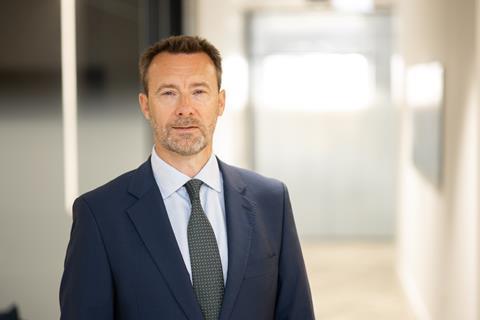Listen to this podcast via Apple, Amazon, Spotify or SoundCloud (and many other platforms) or just use the player below:
Godfrey began working for Tritax in 2001, more than ten years before the establishment of Tritax Big Box, the fund manager’s large-scale logistics REIT that’s now listed on the FTSE250. He says the spur to set up the investment trust came from existing customers wanting to invest on a larger scale in a “more institutional” product.
These conversations were happening amidst the increasing popularity of residential REITs, after the investment model first came into law in 2007. It was then that Godfrey spied an opportunity.
“There was a gap between what people were investing in for their pensions, such as gilts, and more mainstream commercial property offers that were a bit further up the risk curve,” he explains. “We wanted to create something in between.”
The result was Tritax Big Box, which used the REIT model to invest in larger distribution centres, also known as ‘big boxes’. For instance, the firm’s largest asset, in Littlebrook by the River Thames at Dartford, covers an enormous 2.32 million sq ft across four storeys, ranking it among the largest buildings of any kind in Europe.
Establishing a logistics REIT in 2013 allowed the company to have first-mover advantage and build the sort of scale that is so important in listed markets. It also allowed Godfrey and his colleagues to establish long-term relationships with larger customers, which continues to be a vital part of the business as it, along with much of the industry, recognises the importance of operations to income generation.
The team has continued to prove extremely capable at spotting trends ahead of time.
“We recognised the opportunity in large-scale logistics before most other people caught on the emergence of the regional distribution model,” Godfrey says. “The internet meant retailers had to be able to sell every product, everywhere, to everyone in the nation.”
One of the more recent trends in the logistics space has been the increasing amount of manufacturing that is being ‘re-shored’, or brought back to the company’s original country. In Tritax Big Box’s case, the firm decided to re-shore the majority of its product sourcing.
“Where we can, we now source from inside the UK,” Godfrey notes. “It’s not about flying the flag. It means we understand our supply chain better and we’re able to give our customers confidence about delivering buildings on time.”
Perhaps the most important vehicle for delivering buildings has been Tritax Symmetry, Big Box’s land and development platform. As far back as 2013, Godfrey had argued that the logistics space was looking towards yield compression.
“To deliver high quality returns without moving up the risk curve, we needed to have other elements in our armoury,” he remarks.
Acquired in 2019, Tritax Symmetry is now “the largest logisticsland platform in the UK,” Godfrey says. “It gives us the ability to create a really high-quality, modern product at a much more attractive yield on cost.”
As an example of this strategy, Big Box recently exchanged on three assets for £125 million at a 4.6 percent blended initial yield. This cash will be reinvested into new opportunities, including developments, at a 6-8 percent yield on cost.
When it comes to ESG, Godfrey says that Big Box has had “the philosophy of leading from the front”.
“Some customers had to be dragged through a hedge backwards,” he says, referring to when he needed to point to their own corporate ESG targets in order to push for greater sustainability in the asset Big Box was delivering. “If you leave it to the market, you’ll end up with a substandard product that will quickly be outdated in terms of modern requirements,” he continues.
And logistics is a particularly modern asset class. New distribution centres are packed full of robots, powered by AI, and often served by electric vehicles, meaning they have huge demands for the fastest internet and greatest power efficiency.
Delivering this while keeping the highest standards of sustainability has proved a challenge – and Godfrey says that the EV revolution will only make things more difficult.
“There’s probably not a single logistics building in the UK right now that’s capable of fulfilling the future government requirements for EVs,” he says. To meet the demand, Big Box is building power centres into its logistics parks and betting big on solar, since its buildings “have the largest roofs of any UK building type”. Its Littlebrook centre is able to deliver an impressive 3.5 megawatts of power through solar alone.
Asked how repricing amidst the current economic turbulence is going to affect the REIT’s strategy, Godfrey doesn’t mince words: “Massively,” he says. “It’s all about macro.”
Still, he’s bullish about the long-term fundamentals of the business. “Real estate is a long-term asset class,” he points out. “Based on what we set out to achieve, and what we told the market we would be doing, we’re delivering on that.”
Listen to this podcast via Apple, Amazon, Spotify or SoundCloud (and many other platforms) or use the player above.







































No comments yet